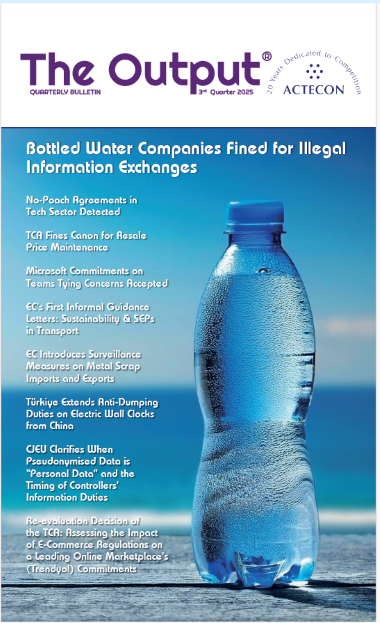The Ministry to Go Unorthodox for Calculating the Dumping Margins: Vulcanised Rubber Thread and Cord
| International Trade

Article By Ertuğrul Can Canbolat
The Ministry to Go Unorthodox for Calculating the Dumping Margins: Vulcanised Rubber Thread and Cord
Authors: Ertuğrul Can Canbolat
Lexology, 29.11.2024
Introduction
In July 2024, the Republic of Türkiye Ministry of Trade (“Ministry”) Directorate General for Imports (“Directorate General”) had announced its Final Disclosure Report1 (the “First Final Disclosure”) regarding the investigation carried out concerning the imports of the product vulcanised rubber thread and cord (“concerned product”) originating in the Republic of India (“India”). The Directorate General surprisingly published a further Final Disclosure Report2 (the “Revised Final Disclosure”) in September 2024, according to which a different approach was adopted for the dumping margin calculation.
This Revised Final Disclosure could result in a decision of an utterly exceptional nature since it diverges from most of the previous decisions with respect to dumping margin calculations and can also affect the dumping margin analyses of the Ministry to be done during incoming investigations, particularly those relating to cases with export price fluctuations among regions, purchasers or time periods. This article aims to provide an overview of this exceptional decision from a critical standpoint.
The Investigation and The Final Disclosures
The investigation was initiated following an application submitted by the Domestic Industry, which is composed of Elpa as the applicant and Şahin Lateks Sanayi ve Tic. A.Ş. (“Şahin”) as the supporter. The investigation period (“IP”) was determined as the period between 1 April 2022 and 31 March 2023, while the injury review period was determined as between 1 January 2020 31 March 2023. Located in India, Rubfila International Limited (“Rubfila”), producer/exporter of the concerned product, as well as the two importers of the concerned product into Türkiye, have provided the Ministry with their responses to the questionnaire. Therefore, the dumping determinations concerning Rubfila have been made based on the data provided by it, the only cooperating company located in India.
As anticipated, the dumping margin for the cooperating party was calculated by comparing the normal value and export prices on a weighted average basis. The dumping margin was determined to be 3.13% for Rubfila and 9.30% for others.
Regarding the injury, the First Final Disclosure finds that (i) the imports of the concerned product originating in India have increased in quantity by 120%, (ii) the market share of these imports increased significantly by 102%, (iii) the dumped imports undercut the domestic market sales prices of the Domestic Industry with regard to the concerned product in 2020, 2021, and 2022, (iv) during the IP, price undercutting was replaced by price depression due to the fact that the Domestic Industry lowered its sales prices, (v) the domestic sales quantities, unit prices, and profitability of the Domestic Industry have decreased since 2021, (vi) the production and capacity utilisation rate (“CUR”) decreased during the IP compared to 2021, (vii) the domestic industry operated with a low CUR, while having its total profitability decreased and stocks increased during the injury review period. The First Final Disclosure stated that the dumped imports and the injury caused to the economic indicators of the Domestic Industry took place simultaneously, suggesting the existence of a causal link between the two; and it is considered that other factors that might have caused injury are not sufficient to eliminate the causal link between the dumping and the injury.
Just a few weeks following the publication of the First Final Disclosure, interestingly, another final disclosure report was published on the Ministry’s website, i.e., the Revised Final Disclosure. Apparently, upon having comments raised by the applicants, the dumping margin calculation was modified on the basis that the prices of the imports from India differ significantly throughout the IP and that a comparison of a normal value established on a weighted average basis and prices of individual export transactions is required within the framework of Article 11 of the Regulation and Article 2.4.2 of the Agreement on Implementation of Article VI of the General Agreement on Tariffs and Trade 1994 (“Anti- Dumping Agreement”).
While concluding so, the Revised Final Disclosure relies on the analysis of Rubfila’s export prices following the views expressed by the domestic industry. As a result of its evaluation, the objections raised by the domestic industry regarding the calculation were found reasonable and it was determined that the export prices of Rubfila varied significantly throughout the IP. Accordingly, since the method of comparing the weighted average normal value with the weighted average of the export prices was insufficient to determine the dumping arising from the price differentiation throughout the IP, the dumping margin was recalculated by comparing the weighted average normal value with the export prices on a transaction basis in accordance with Article 11 of the Regulation in order to fully and thoroughly reveal the magnitude of dumping and to reveal targeted dumping, if any.
By employing the abovementioned method for calculating the dumping margin in the Revised Final Disclosure, a rate of 7.1% of the CIF value was reached for Rubfila and 12.3% of the CIF value was determined for others.
Both within the scope of the Revised Final Disclosure as well as the previous case-law examples provided below, the dumping margin calculation methods were justified by referencing the national legislation, namely Article 11 of the Regulation stating that:
“Dumping margin shall be established by a comparison of normal value and export price on a weighted average or transaction basis. However, a normal value established on a weighted average basis may be compared to prices of individual export transactions, if there is a pattern of export prices which differs significantly among different purchasers, regions or time periods, and if the comparison on weighted average or transaction basis would not reflect the full degree of dumping being practised.”
In parallel, the second sentence of Article 2.4.2 of the Anti-Dumping Agreement also allows for the utilisation of such test, the only difference being the requirement of the provision of an explanation as to why the differences cannot be duly taken into account by the use of a weighted average-to-weighted average or transaction-to-transaction comparison:
“A normal value established on a weighted average basis may be compared to prices of individual export transactions if the authorities find a pattern of export prices which differ significantly among different purchasers, regions or time periods, and if an explanation is provided as to why such differences cannot be taken into account appropriately by the use of a weighted average-to-weighted average or transaction-to-transaction comparison.”
Although there being a limited number of and relatively older examples, the Ministry, in the past, compared weighted average normal values with prices of individual export transactions. The following exemplifies the Ministry’s past practice utilising the method employed within the scope of the Revised Final Disclosure:
─ One example of this practice dates to 2004, where the Ministry reviewed the dumping allegations of the same Elpa and Şahin, the first as the applicant and the latter as one of the supporters of the application, into the imports of the concerned products defined above, this time originating in Malaysia3. The Ministry has, this time, also referenced the second sentence of Article 2.4.2 of the Anti-Dumping Agreement, the reason being the need to respond the Ministry of Investment, Trade and Industry of.
Malaysia’s allegations that the dumping margin calculations were incompatible with the law of the World Trade Organization as well as the Anti-Dumping Agreement.
─ Within the scope of another example from the year 2004, the Ministry investigated the allegations that baby carriages, strollers, pushchairs, and similar vehicles for carrying children originating in the People’s Republic of China (“PRC”) were being dumped into Türkiye4.
─ A further example from the same year was the dumping investigation concluded concerning the imports of motorcycle tires and tubes originating in Vietnam and the Chinese Taipei5.
─ One last example of the employment of this method from the same year was the time the Ministry investigated the allegations of dumped imports of bicycle tires and tubes originating in Vietnam, the Chinese Taipei, and Sri Lanka6.
─ Another instance the Ministry has used this method during an investigation was the dumping investigation into the imports of certain types of new pneumatic tires of rubber originating in PRC7.
─ The same practice is seen within the scope of the dumping investigation concerning the imports of polyethylene terephthalate of a viscosity of 78 ml/g or more originating in India, Thailand, the Chinese Taipei, South Korea (“Korea”), Malaysia, Indonesia, and PRC8.
─ A further illustration of the same practice embodied in the Ministry’s expiry review investigation concerning the imports of filament yarns of polyester originating in Korea9.
─ A relatively newer yet a hardly recent example of utilisation of the same method is the new exporter review investigation concerning the imports of woven fabrics of synthetic filament yarn for clothing originating in Malaysia10. Accordingly, and as illustrated by means of the examples, the method of making use of a weighted average to individual transaction basis is allowed under both the national and international legislation the Ministry is bound by. However, even though employing this method and departing from the long-established precedent years later merely constitutes an exception, the Revised Final Disclosure appreciably signifies the possibility of utilisation of this method for future dumping margin calculations, in particular with regard to the cases of suspicion that might include dumping that targets certain regions, purchasers or time periods; thereby creating another layer of burden for exporters.
1 https://ticaret.gov.tr/data/6501977713b8769d98616a1c/Nihai%20Bildirim.pdf
2 https://ticaret.gov.tr/data/6501977713b8769d98616a1c/Nihai%20Bildirim_Revize.pdf
3 Communiquéon Prevention of Unfair Competition in Imports numbered 2004/1, published in the Official Gazette dated 29.01.2004 and numbered 25361.
4 Communiqué on Prevention of Unfair Competition in Imports numbered 2004/15, published in the Official Gazette dated 01.08.2004 and numbered 25540.
5 Communiqué on Prevention of Unfair Competition in Imports numbered 2004/21, published in the Official Gazette dated 27.09.2004 and numbered 25596.
6 Communiqué on Prevention of Unfair Competition in Imports numbered 2004/22, published in the Official Gazette dated 27.09.2004 and numbered 25596.
7 Communiqué on Prevention of Unfair Competition in Imports numbered 2005/18, published in the Official Gazette dated 20.08.2005 and numbered 25912.
8 Communiqué on Prevention of Unfair Competition in Imports numbered 2006/01, published in the Official Gazette dated 27.01.2006 and numbered 26062.
9 Communiqué on Prevention of Unfair Competition in Imports numbered 2006/12, published in the Official Gazette dated 18.05.2006 and numbered 26172.
10 Communiqué on Prevention of Unfair Competition in Imports numbered 2009/39, published in the OfficialGazette dated 19.02.2009 and numbered 27437.







